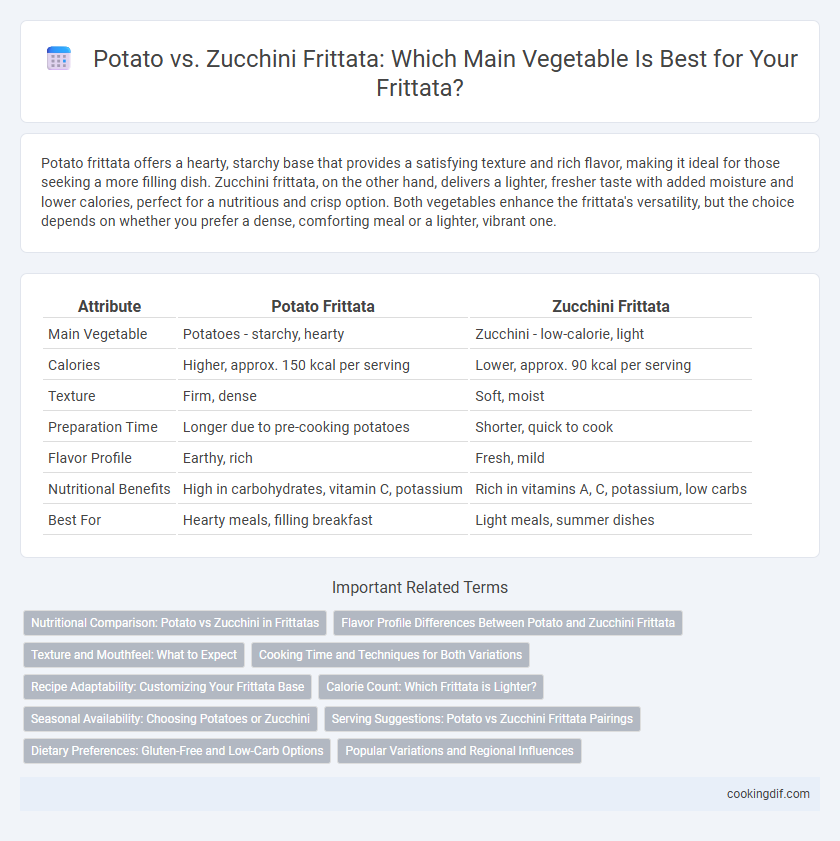Potato frittata offers a hearty, starchy base that provides a satisfying texture and rich flavor, making it ideal for those seeking a more filling dish. Zucchini frittata, on the other hand, delivers a lighter, fresher taste with added moisture and lower calories, perfect for a nutritious and crisp option. Both vegetables enhance the frittata's versatility, but the choice depends on whether you prefer a dense, comforting meal or a lighter, vibrant one.
Table of Comparison
| Attribute | Potato Frittata | Zucchini Frittata |
|---|---|---|
| Main Vegetable | Potatoes - starchy, hearty | Zucchini - low-calorie, light |
| Calories | Higher, approx. 150 kcal per serving | Lower, approx. 90 kcal per serving |
| Texture | Firm, dense | Soft, moist |
| Preparation Time | Longer due to pre-cooking potatoes | Shorter, quick to cook |
| Flavor Profile | Earthy, rich | Fresh, mild |
| Nutritional Benefits | High in carbohydrates, vitamin C, potassium | Rich in vitamins A, C, potassium, low carbs |
| Best For | Hearty meals, filling breakfast | Light meals, summer dishes |
Nutritional Comparison: Potato vs Zucchini in Frittatas
Potato frittatas offer higher carbohydrate content and more calories per serving compared to zucchini frittatas, making them a more energy-dense option. Zucchini frittatas provide fewer calories and carbohydrates but contain more water and dietary fiber, which support digestion and hydration. Both vegetables supply essential vitamins and minerals, with potatoes rich in potassium and vitamin C, while zucchini contributes antioxidants like lutein and vitamin A.
Flavor Profile Differences Between Potato and Zucchini Frittata
Potato frittata delivers a rich, earthy flavor and a hearty, dense texture that provides a satisfying bite, while zucchini frittata offers a lighter, more delicate taste with a subtle sweetness and higher moisture content. The starchiness of potatoes enhances the creamy egg mixture, creating a comforting and robust dish. Zucchini's mild, fresh flavor pairs well with herbs and cheese, resulting in a vibrant, tender frittata that feels less heavy.
Texture and Mouthfeel: What to Expect
Potato frittata offers a dense, creamy texture with tender, slightly crispy edges, providing a hearty mouthfeel that holds well in slices. Zucchini frittata delivers a lighter, moister consistency with a delicate, silky bite due to the vegetable's high water content. Texture-wise, potatoes create a more substantial, satisfying chew, while zucchini yields a soft and smooth experience.
Cooking Time and Techniques for Both Variations
Potato frittata requires longer cooking time due to the dense texture of potatoes, often involving pre-cooking or sauteing slices to ensure tenderness before baking or finishing on the stovetop. Zucchini frittata cooks faster as zucchini releases moisture quickly, necessitating careful sauteing to avoid sogginess and achieve a firm consistency. Mastery of heat control and timing is essential for both variations to balance texture and flavor perfectly.
Recipe Adaptability: Customizing Your Frittata Base
Potato frittata offers a hearty, starchy base that retains moisture and adds a creamy texture, making it ideal for recipes requiring a more filling dish. Zucchini frittata provides a lighter, low-carb option with a subtle sweetness and higher water content, which requires careful moisture management to avoid sogginess. Both vegetables allow versatile customization of the frittata's flavor profile and nutritional balance, catering to different dietary preferences and texture preferences.
Calorie Count: Which Frittata is Lighter?
Potato frittatas typically contain higher calories due to the dense starch content in potatoes, averaging around 150-200 calories per serving, compared to zucchini frittatas, which often range from 100-140 calories per serving because zucchini has a higher water content and fewer carbs. The calorie difference is significant for those aiming to manage calorie intake while enjoying a vegetable-rich frittata. Choosing zucchini as the main vegetable can make the dish lighter and more suitable for low-calorie diets without sacrificing volume or texture.
Seasonal Availability: Choosing Potatoes or Zucchini
Potatoes, typically harvested in late summer through fall, offer a hearty texture ideal for cooler months, while zucchinis flourish in the peak of summer, providing a lighter, moist element perfect for warm weather meals. Seasonal availability makes potatoes a more accessible choice during autumn and winter, whereas zucchinis support fresh, garden-inspired dishes in spring and summer. Selecting the main vegetable based on seasonality ensures optimal flavor, texture, and nutrient content in a frittata.
Serving Suggestions: Potato vs Zucchini Frittata Pairings
Potato frittatas pair excellently with fresh arugula salad, roasted cherry tomatoes, and crusty sourdough bread, balancing the dish's heartiness with bright, crisp flavors. Zucchini frittatas complement Mediterranean sides such as marinated olives, feta cheese, and a light lemon herb dressing, enhancing the dish's light and fresh profile. Both variations work well with a chilled white wine or a citrus-infused sparkling water to elevate the dining experience.
Dietary Preferences: Gluten-Free and Low-Carb Options
Potato frittata offers a naturally gluten-free option rich in complex carbohydrates, ideal for those needing gluten-free meals but less suitable for strict low-carb diets. Zucchini frittata provides a lower-carb, nutrient-dense alternative, favored in ketogenic and low-carb dietary plans while maintaining gluten-free status. Both frittatas deliver vitamins and minerals, but zucchini's lower glycemic impact supports blood sugar management better than potato.
Popular Variations and Regional Influences
Potato frittata is a popular variation commonly found in Italian and Mediterranean cuisines, valued for its hearty texture and earthy flavor that pairs well with robust herbs like rosemary and thyme. Zucchini frittata, favored in regions with abundant summer squash harvests such as the American Southwest and Mediterranean, offers a lighter, moist alternative that absorbs spices and cheeses effectively. Both variations reflect regional agricultural influences and dietary preferences, with potatoes lending a classic, filling base and zucchini highlighting a seasonal, fresh vegetable option.
potato frittata vs zucchini frittata for main vegetable Infographic

 cookingdif.com
cookingdif.com